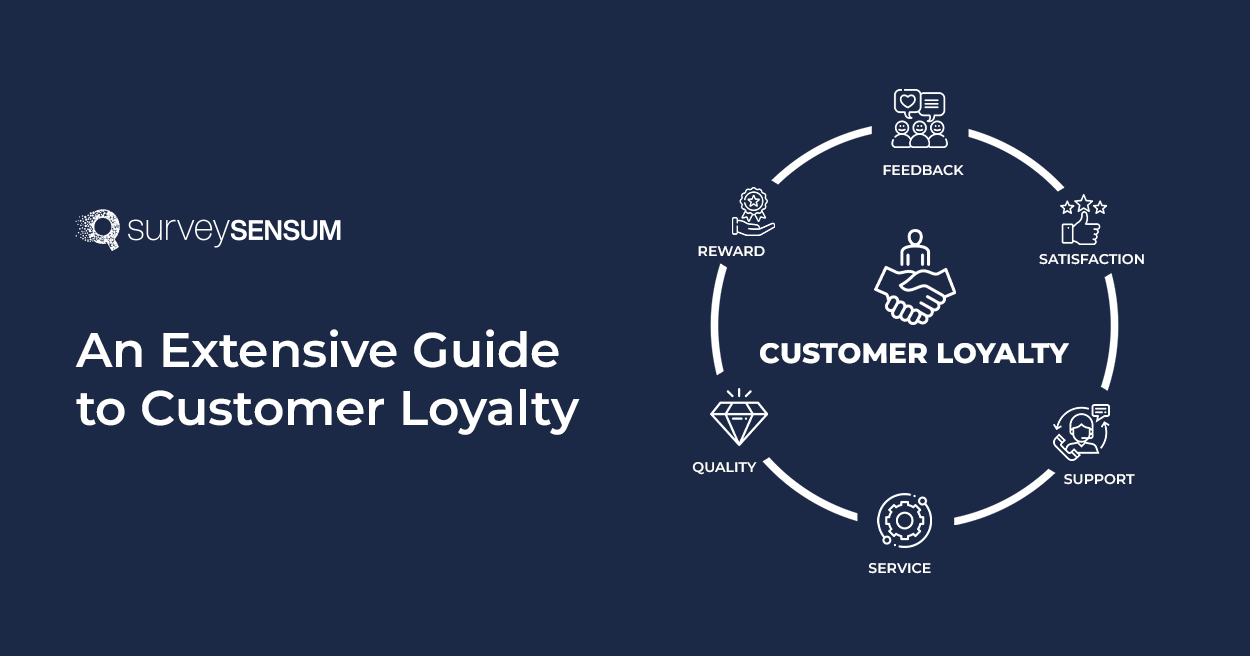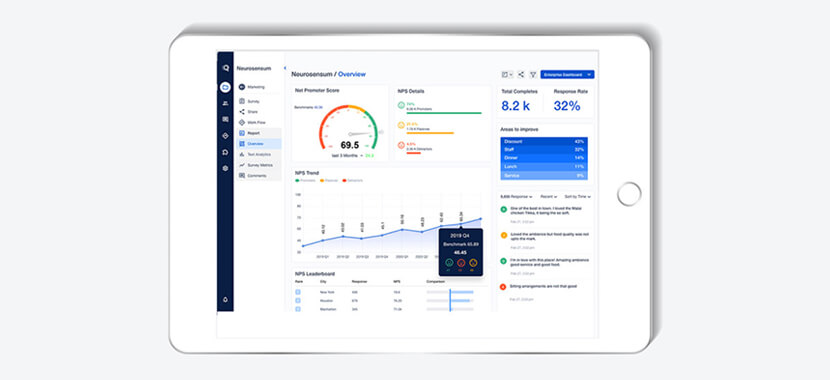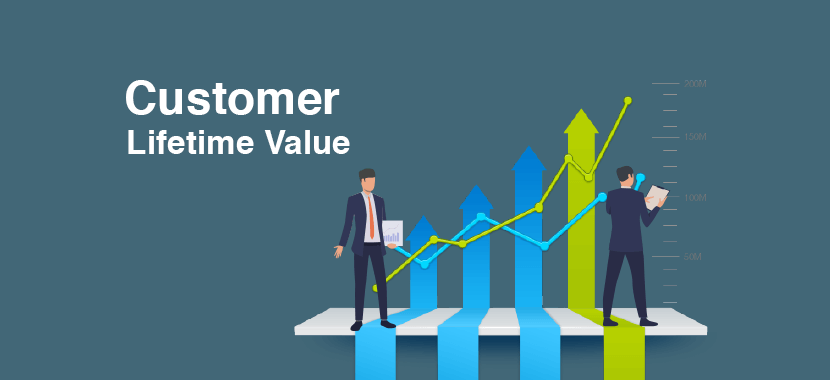
Are you able to retain your existing customers through your products and services?
Well, some brands do it amazingly.
Their customers are their die-hard fans. To give some names – Starbucks, Apple, etc.
You won’t find a loyal Starbucks customer in a queue at Cafe Coffee Day.
But how do these brands leverage their customers and what do they do to turn a stranger into loyal customers?
The key lies in their use of a robust customer feedback platform. This platform enables them to consistently gather feedback, staying attuned to customer expectations and experiences. As a result, they enhance customer satisfaction and foster unwavering loyalty.
Now you must be curious about knowing what customer loyalty is and its impact on your business, right? Worry not my friend because this guide will comprehensively explore all facets of customer loyalty.
So, let’s get started.
What is Customer Loyalty?
Customer loyalty is something that every customer-centric organization desires. All you have to do is build loyalty brick by brick.
In simple words, your business needs to deliver multiple positive customer experiences to let your customers choose you over your competitors. This will ultimately lead to building strong loyalty.
You have to deliver top-notch customer experience at ALL times. Also, it goes beyond simple customer satisfaction and involves a strong emotional and psychological connection between the customer and the brand.
So, if you continue giving them what they want, they will stick like glue with your brand.
To understand this better, here’s an example of Disneyland.
Disneyland is pro in giving magical experiences and exceptional customer service. They have fostered unwavering loyalty among visitors. For some families it has also become a ritual to return year after year, to create worth-it memories. They have also become devoted brand advocates.
Now you know what customer loyalty is but do you know how it can be beneficial for your business?
This brings us to the importance.
Importance of Customer Loyalty
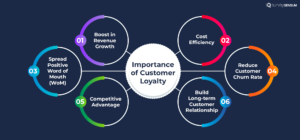
Customer loyalty is vital for your sustainable business growth. With the loyalty of your customers, your business can become profitable, boost customer advocacy, and maintain a competitive edge in the market.
Let’s understand each one in detail and explore other key reasons that demonstrate why customer loyalty is important:
1. Boost in Revenue Growth
Your loyal customers will repurchase over time and that will increase your sales.
But why will they do that?
They will do if you continue prioritizing them and keep on delivering exceptional services. Also, they are more likely to try new products or services offered by your brand, further driving revenue growth.
2. Cost Efficiency
Several brands leverage their existing customers as acquiring a new customer can be up to 25 times more expensive than retaining an existing one – Harvard Business Review.
This is why we say retain your existing customers because they are cost-efficient. So, that you can invest in serving your customers better.
Also, retaining existing customers will help you to build customer loyalty and maintain strong relationships. This leads to reducing the need for constant customer acquisition efforts, saving resources, and improving overall cost efficiency.
3. Spread Positive Word-of-Mouth
A loyal customer is worth their weight in gold!
Your loyal customers are valuable as they become brand advocates, willingly promoting and recommending your brand to others. They can share their positive experiences through word-of-mouth, social media platforms, online reviews, and so on. And you can also promote their words through your marketing campaigns, and testimonials.
This positive word-of-mouth marketing can help you to attract new customers and improve the brand’s reputation and credibility.
4. Reduce Customer Churn Rate
With an increase in customer loyalty, you can reduce customer churn.
How?
To reduce customer churn you need to have a real-time survey system that immediately notifies you when bad customer feedback arrives. So that you can take appropriate action.
Also, your loyal customers are less likely to switch to competitors, even when they offer attractive discounts.
So, by simply focusing on building customer loyalty, you can increase customer retention rates, ensuring a stable customer base and minimizing revenue loss from customer attrition.
5. Competitive Advantage
Your loyal customers can give you insight into
- why they choose you over your competitors and
- how they get to know about you.
All this feedback will help you to improve your products and services and continue to deliver what your customers love the most. This will enable your brand to have a competitive edge in the market and make you significantly different from the rest.
6. Build Long-term Customer Relationships
Building a long-term relationship with your customers can benefit your business in various ways. Once you build a long-term customer relationship, then you will find them more forgiving of occasional shortcomings, and you can offer opportunities to recover from service failures.
Try to strengthen customer relationships because these enduring relationships foster trust, loyalty, and a sense of partnership between the brand and your customers.
So, start focusing on building and nurturing customer loyalty because that can give you all these above-mentioned benefits and simultaneously can enhance customer satisfaction, drive revenue, and establish a strong foundation for your business’s long-term success.
That was about the importance of customer loyalty, moving forward, let’s have a glance at factors that can influence it.
Factors that Influence Customer Loyalty
Here are the factors that can significantly affect your customer’s loyalty.
1. Quality Products and Services
To offer high-quality products and services, invest in conducting customer feedback surveys, research and development, product testing, and continuous improvement processes. By doing this you can understand and meet customers’ expectations because they value quality as it ensures satisfaction, reliability, and value for their money.
2. Exceptional Customer Service
Give proper training and empower employees to deliver personalized, responsive, and empathetic service to resolve customer issues promptly and effectively. This will create positive experiences, build trust, and demonstrate care for customers.
Example: Amazon offers exceptional customer service by offering 24/7 live chat support, quick response times, and hassle-free returns. Customers who receive prompt and helpful assistance are more likely to develop loyalty toward the brand.
3. Building Relationships
Build strong customer relationships to understand their needs and preferences. To do that, engage with them in personalized communication and maintain regular contact. This will build rapport, address concerns, and show appreciation for customer loyalty.
Example: Gucci has recently aligned itself with multiple causes and supports sustainability. Customers who share the brand’s values and feel emotionally connected to its mission are more likely to stay loyal and identify with the brand’s image.
4. Personalized Experiences
Use technology to gather and analyze customer data to know their likes and dislikes, create personalized recommendations, and offer targeted discounts. Delivering customized interactions across various touchpoints can boost customer satisfaction, engagement, and loyalty.
5. Consistency and Reliability
Offering consistency in product quality, service delivery, and customer experiences builds trust and reliability. This establishes and adheres to standard processes, quality control measures, and service level agreements leading to influence customer loyalty.
6. Competition and Alternatives
Competition and alternatives play a crucial role in shaping customer loyalty. They raise expectations by offering options. To keep loyalty, understand and address competitors and alternatives effectively.
7. Convenience and Accessibility
Customers value convenience and accessibility because it saves time and effort, and provides a seamless experience. You can enhance this by offering online shopping, mobile apps, multiple payment options, and efficient customer service.
8. Brand Reputation and Trust
Brand reputation and trust are crucial as they show the perception and credibility a brand has established among its customers. Customers value both because it provides assurance of consistent quality, customer service, and positive experiences. You can build brand reputation and trust through consistent delivery of quality products/services, transparent communication, ethical practices, and by responding effectively to customer feedback.
9. Pricing and Value
Your customers can come to your business when they consider pricing and value because they want to ensure they are getting a fair deal and maximum benefits for their investment. You can offer competitive pricing, discounts, loyalty programs, or additional benefits to demonstrate value to customers.
By considering all these factors in mind, you can foster stronger customer relationships, and enhance customer loyalty.
But
How to Build Customer Loyalty?
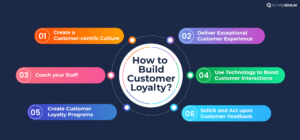
Know how to build customer loyalty effectively here:
1. Create a Customer-centric Culture
Create a customer-centric culture to keep your customers at the center of your business decisions to understand their needs and satisfaction.
To create this culture, involve your employees in customer-focused initiatives, train them on customer service, and align company goals with customer satisfaction metrics like CSAT.
2. Deliver Exceptional Customer Experience
Your customers will keep coming back to you if only you deliver exceptional experiences. To do that, have a streamlined feedback process to hear them and close the feedback loop efficiently. Also, offer personalized interactions to create positive emotions, build trust, and differentiate your brand from competitors.
3. Coach your Staff
Well-trained and knowledgeable front-line employees can provide excellent customer service because they’re the ones with whom your customer interacts first and last. So, to represent your brand effectively, launch ongoing training programs, encourage them to participate, empower them to be empathetic, and make customer-centric decisions.
And don’t forget to recognize and reward your employees who are giving exceptional customer service.
4. Use Technology to Elevate Customer Interactions
Elevating your customer interactions with technology can improve efficiency, personalization, and convenience in customer interactions.
To do this, adopt customer relationship management (CRM) systems, implement self-service options like help articles, FAQs, etc, use data analytics for personalized recommendations, and leverage social media and mobile apps to engage your customers.
5. Create Customer Loyalty Programs
Create a customer loyalty program by defining its objective. Design your program in a way that includes attractive rewards and incentives. Make them aware of the benefits of being in the loyalty program. And track and analyze customer data to personalize rewards.
By doing this, your customers will be encouraged to repeat purchases, strengthen the customer-brand relationship, and enhance customer lifetime value (CLV).
6. Solicit and Act upon Customer Feedback
Customer feedback is the best way to identify areas for improvement, and customer needs, and enhance the overall customer experience. You can close the feedback loop by implementing feedback mechanisms, such as surveys or online reviews, where you can actively listen to them, analyze them, and take necessary actions to address their concerns and suggestions.
Act on Gathered Customer Feedback with SurveySensum!
By following all these given strategies, you can build strong customer loyalty.
But what will you do after building a strong fan base?
Learn here to know how to measure and manage customer loyalty.👇
How to Measure and Manage Customer Loyalty?
To measure and manage customer loyalty, you can use various key metrics and strategies given here:
1. Key Metrics to Measure Customer Loyalty
You can use
- Net Promoter Score (NPS) survey to measure customer loyalty
- Customer Satisfaction (CSAT) survey to assess the customer satisfaction levels with specific interactions or experiences.
- Customer Retention Rate (CRR) to gauge the percentage of customers who continue to stay loyal and transact with the brand over time.
- Repeat Purchase Rate (RPR) to calculate the percentage of repurchasing customers.
These metrics are key metrics used to measure customer loyalty as they offer quantifiable data to assess customer loyalty levels, identify areas for improvement, and track the success of customer loyalty initiatives.
So, implement these surveys to measure these metrics effectively.
Launch Your First NPS, CSAT, or CES Survey for Free!
2. Implementing Customer Relationship Management (CRM) Systems
By implementing CRM systems into your business you can keep your customer information in one place. This will enable you to understand their preferences and create personalized interactions, leading to enhancing customer loyalty.
All you have to do is adopt CRM software, integrate customer data from multiple touchpoints, and use it to analyze and leverage customer insights.
3. Customer Lifetime Value (CLTV)
With customer lifetime value, you can understand the predicted net profit a business can earn from a customer over their entire relationship.
Thus, know the long-term value and profitability of customers, so that you can allocate resources effectively to maximize their loyalty.
You can calculate CLTV by considering average purchase value, purchase frequency, and customer retention rate.
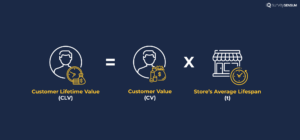
4. Analyzing Customer Data to Identify Trends
Analyze the gathered customer data because that will let you dive deeper into their insights, needs, and preferences.
With the data, you can personalize offerings, identify opportunities to strengthen customer loyalty, and make informed business decisions.
You can also use Text Analytics Software, an AI tool of SurveySensum that lets you analyze open-ended feedback and segregate good, bad, and average feedback by identifying key trends and sentiments.
We have talked about everything but what’s more?
Here are a few challenges that you may encounter while building customer loyalty. However, worry not because we have come up with solutions as well.
Challenges and Solutions
We understand building customer loyalty can be challenging but here are common challenges in building customer loyalty, along with examples, and strategies to overcome them:
1. Increasing Customer Expectations
Nowadays, customers’ expectations are speedily rising, driven by modern technology, changing market trends, and experiences with other brands.
To get rid of this challenge, you need to
- Regularly assess customer needs
- Identify areas for improvement
- Innovate to exceed expectations
- Embrace customer feedback
- Actively listen to customer feedback
- Address concerns
- Make necessary adjustments to enhance the customer experience
2. Competition and Market Saturation
The intense competition and market saturation make it difficult to differentiate and capture customers’ attention and loyalty.
That’s why you need to offer unique products, services, or experiences that set your business apart from your competitors.
Also, you can involve customers in the development process to seek their input and customize offerings based on their preferences.
3. Maintain Consistency across Multiple Touchpoints
Businesses aim to create consistent experiences across different touchpoints like physical stores, online platforms, and customer support channels. This can be tough that’s why here’s a solution:
- Tell your customers about your consistent brand values, tone, and customer service standards across all touchpoints.
- Implement systems and tools to streamline processes, automate customer interactions, and ensure consistency in delivering the best customer service.
Address these challenges strategically to strengthen customer loyalty and maintain a competitive edge in the market.
Now it’s time to conclude our entire discussion.
Conclusion
Whether it’s purchasing cars or everyday groceries, customer loyalty holds significant importance. It leads to repeated buying, counters competition, and boosts higher-margin extra sales. Moreover, it decreases marketing and acquiring new customers costs.
There is no single number or metric that can showcase customer loyalty. A variety of metrics are required to gauge it accurately. These loyalty metrics offer insight into the depth of customer loyalty.
So, in the quest for boosting your customer’s loyalty, a powerful tool like SurveySensum can be immensely helpful.







